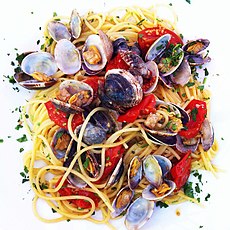| Revision as of 17:22, 9 January 2025 editNick.mon (talk | contribs)Autopatrolled, Extended confirmed users57,182 edits ←Created page with '{{Italian cuisine}} '''Emilian cuisine''' consists of the cooking traditions and practices of the region of Emilia in Italy. As in most regions of Italy, more than a cuisine, it is a constellation of cuisines that, in Emilia, represents the result of nearly eight centuries of autonomy of the Emilian cities, from the time of the Communes to the Unification of Italy. == History == The divergence of historical paths between the Po...' | Revision as of 17:25, 9 January 2025 edit undoNick.mon (talk | contribs)Autopatrolled, Extended confirmed users57,182 edits →HistoryNext edit → | ||
| Line 4: | Line 4: | ||
| == History == | == History == | ||
| The divergence of historical paths between the Popes-dominated Emilia and the duchies' one had consequences that are also felt in the culinary and gastronomic fields. While contrasts prevail over similarities between Romagna’s cuisine, incorporated for nearly four hundred years into the Papal States, and that of Emilia, the cuisines of the different Emilian cities form a picture that, although highly varied, nonetheless presents significant common traits. The cuisine of ] is somewhat of an exception, characterized by influences from ] as well as from ], and that of ], due to its eccentric position, has developed and preserved distinctly unique features. | The divergence of historical paths between the Popes-dominated Emilia and the duchies' one had consequences that are also felt in the culinary and gastronomic fields. While contrasts prevail over similarities between Romagna’s cuisine, incorporated for nearly four hundred years into the Papal States, and that of Emilia, the cuisines of the different Emilian cities form a picture that, although highly varied, nonetheless presents significant common traits. The cuisine of ] is somewhat of an exception, characterized by influences from ] as well as from ], and that of ], due to its eccentric position, has developed and preserved distinctly unique features.<ref>''Maria Luigia e la corte, in A tavola con Maria Luigia''. Zannoni M., 1991</ref> | ||
| Precisely because it was governed by powerful noble families, at whose courts the most celebrated chefs worked, Emilia has great gastronomic traditions. Throughout the ] and ]s, two culinary "schools" dominated the country: the Roman one at the papal court and, indeed, the Emilian one. In Ferrara, Giovan Battista Rossetti and Cristoforo di Messisbugo were active; in ], it seems, Vincenzo Cervio served; in ], Giulio Cesare Tirelli and Bartolomeo Stefani were at work. It is likely that the Emilian cuisine inherited from the five and sixteenth-century traditions the characteristics of opulence and extravagance for which Bologna is still called ''la Grassa'' (the Fat).<ref>''Almanacco della ducal corte di Parma'', ], 1845.</ref><ref>''Almanacco di corte per l’anno 1819'', ], 1819.</ref><ref>''Le ricette di Alberto Alvisi cuoco del cardinale Chiaramonti vescovo di Imola 1785-1800.'' Bessani |
Precisely because it was governed by powerful noble families, at whose courts the most celebrated chefs worked, Emilia has great gastronomic traditions. Throughout the ] and ]s, two culinary "schools" dominated the country: the Roman one at the papal court and, indeed, the Emilian one. In Ferrara, Giovan Battista Rossetti and Cristoforo di Messisbugo were active; in ], it seems, Vincenzo Cervio served; in ], Giulio Cesare Tirelli and Bartolomeo Stefani were at work. It is likely that the Emilian cuisine inherited from the five and sixteenth-century traditions the characteristics of opulence and extravagance for which Bologna is still called ''la Grassa'' (the Fat).<ref>''Almanacco della ducal corte di Parma'', ], 1845.</ref><ref>''Almanacco di corte per l’anno 1819'', ], 1819.</ref><ref>''Le ricette di Alberto Alvisi cuoco del cardinale Chiaramonti vescovo di Imola 1785-1800.'' Bessani A. & Roveri G., 1984</ref> | ||
| == References == | == References == | ||
Revision as of 17:25, 9 January 2025
 |
| Italian cuisine |
|---|
| History |
| Regional cuisines |
| Lists |
| See also |
|
|
Emilian cuisine consists of the cooking traditions and practices of the region of Emilia in Italy. As in most regions of Italy, more than a cuisine, it is a constellation of cuisines that, in Emilia, represents the result of nearly eight centuries of autonomy of the Emilian cities, from the time of the Communes to the Unification of Italy.
History
The divergence of historical paths between the Popes-dominated Emilia and the duchies' one had consequences that are also felt in the culinary and gastronomic fields. While contrasts prevail over similarities between Romagna’s cuisine, incorporated for nearly four hundred years into the Papal States, and that of Emilia, the cuisines of the different Emilian cities form a picture that, although highly varied, nonetheless presents significant common traits. The cuisine of Piacenza is somewhat of an exception, characterized by influences from Lombard cuisine as well as from Ligurian cuisine, and that of Ferrara, due to its eccentric position, has developed and preserved distinctly unique features.
Precisely because it was governed by powerful noble families, at whose courts the most celebrated chefs worked, Emilia has great gastronomic traditions. Throughout the Renaissance and Baroque periods, two culinary "schools" dominated the country: the Roman one at the papal court and, indeed, the Emilian one. In Ferrara, Giovan Battista Rossetti and Cristoforo di Messisbugo were active; in Parma, it seems, Vincenzo Cervio served; in Bologna, Giulio Cesare Tirelli and Bartolomeo Stefani were at work. It is likely that the Emilian cuisine inherited from the five and sixteenth-century traditions the characteristics of opulence and extravagance for which Bologna is still called la Grassa (the Fat).
References
- Maria Luigia e la corte, in A tavola con Maria Luigia. Zannoni M., 1991
- Almanacco della ducal corte di Parma, Parma, 1845.
- Almanacco di corte per l’anno 1819, Modena, 1819.
- Le ricette di Alberto Alvisi cuoco del cardinale Chiaramonti vescovo di Imola 1785-1800. Bessani A. & Roveri G., 1984